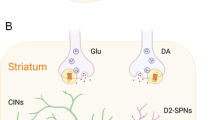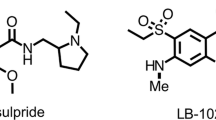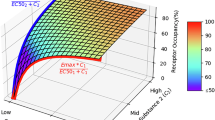Abstract
Blockade of dopamine D2 receptors remains a common feature of all antipsychotics. It has been hypothesized that the extrastriatal (cortical, thalamic) dopamine D2 receptors may be more critical to antipsychotic response than the striatal dopamine D2 receptors. This is the first double-blind controlled study to examine the relationship between striatal and extrastriatal D2 occupancy and clinical effects. Fourteen patients with recent onset psychosis were assigned to low or high doses of risperidone (1 mg vs 4 mg/day) or olanzapine (2.5 mg vs 15 mg/day) in order to achieve a broad range of D2 occupancy levels across subjects. Clinical response, side effects, striatal ([11C]-raclopride-positron emission tomography (PET)), and extrastriatal ([11C]-FLB 457-PET) D2 receptors were evaluated after treatment. The measured D2 occupancies ranged from 50 to 92% in striatal and 4 to 95% in the different extrastriatal (frontal, temporal, thalamic) regions. Striatal and extrastriatal occupancies were correlated with dose, drug plasma levels, and with each other. Striatal D2 occupancy predicted response in positive psychotic symptoms (r=0.62, p=0.01), but not for negative symptoms (r=0.2, p=0.5). Extrastriatal D2 occupancy did not predict response in positive or negative symptoms. The two subjects who experienced motor side effects had the highest striatal occupancies in the cohort. Striatal D2 blockade predicted antipsychotic response better than frontal, temporal, and thalamic occupancy. These results, when combined with the preclinical data implicating the mesolimbic striatum in antipsychotic response, suggest that dopamine D2 blockade within specific regions of the striatum may be most critical for ameliorating psychosis in schizophrenia.
Similar content being viewed by others
Log in or create a free account to read this content
Gain free access to this article, as well as selected content from this journal and more on nature.com
or
References
Agid O, Kapur S, Arenovich T, Zipursky RB (2003). Delayed-onset hypothesis of antipsychotic action: a hypothesis tested and rejected. Arch Gen Psychiatry 60: 1228–1235.
Alexander GE, DeLong MR, Strick PL (1986). Parallel organization of functionally segregated circuits linking basal ganglia and cortex. Annu Rev Neurosci 9: 357–381.
Arnt J, Skarsfeldt T (1998). Do novel antipsychotics have similar pharmacological characteristics? A review of the evidence. Neuropsychopharmacology 18: 63–101.
Arnt J, Skarsfeldt T, Hyttel J (1997). Differentiation of classical and novel antipsychotics using animal models. Int Clin Psychopharmacol 12 (Suppl 1): S9–S17.
Barnes TR (1989). A rating scale for drug-induced akathisia. Br J Psychiatry 154: 672–676.
Bigliani V, Mulligan RS, Acton PD, Ohlsen RI, Pike VW, Ell PJ et al (2000). Striatal and temporal cortical D2/D3 receptor occupancy by olanzapine and sertindole in vivo: a [123I]epidepride single photon emission tomography (SPET) study. Psychopharmacology (Berlin) 150: 132–140.
Bremner JD, Bronen RA, De Erasquin G, Vermetten E, Staib LH, Ng CK et al (1998). Development and reliability of a method for using magnetic resonance imaging for the definition of regions of interest for positron emission tomography. Clin Positron Imaging 1: 145–159.
Chronister RB, DeFrance JF (1981). Nucleus accumbens in historical perspective. In: Chronister RB, DeFrance JF (eds). The Neurobiology of the Nucleus Accumbens. Haer Institute for Electrophysiological Research: Brunswick, Maine. pp 1–6.
de Haan L, van Bruggen M, Lavalaye J, Booij J, Dingemans PM, Linszen D (2003). Subjective experience and D2 receptor occupancy in patients with recent-onset schizophrenia treated with low-dose olanzapine or haloperidol: a randomized, double-blind study. Am J Psychiatry 160: 303–309.
Efron B (1982). The Jackknife, the Bootstrap and Other Resampling Plans. SIAM: Bristol.
Farde L, Nordstrom AL, Wiesel FA, Pauli S, Halldin C, Sedvall G (1992). Positron emission tomographic analysis of central D1 and D2 dopamine receptor occupancy in patients treated with classical neuroleptics and clozapine. Relation to extrapyramidal side effects. Arch Gen Psychiatry 49: 538–544.
Farde L, Suhara T, Nyberg S, Karlsson P, Nakashima Y, Hietala J et al (1997). A PET-study of [11C]FLB 457 binding to extrastriatal D2-dopamine receptors in healthy subjects and antipsychotic drug-treated patients. Psychopharmacology (Berlin) 133: 396–404.
Guy W (1976). Clinical Global Impression. US Department of Health, Education, and Welfare, Public Health Service, Alcohol, Drug Abuse, and Mental Health Administration, NIMH Psychopharmacology Research Branch, Division of Extramural Research Programs: Rockville, MD.
Haber SN (2003). The primate basal ganglia: parallel and integrative networks. J Chem Neuroanat 26: 317–330.
Hall H, Farde L, Halldin C, Hurd YL, Pauli S, Sedvall G (1996). Autoradiographic localization of extrastriatal D2-dopamine receptors in the human brain using [125I]epidepride. Synapse 23: 115–123.
Houle S, Kapur S, Hussey D, Jones C, DaSilva J, Wilson A (1996). Measurment of [11C]-raclopride binding using a bolus plus infusion protocol. In: Myers R, Cunningham V, Bailey DL, Jones T (eds). Quantification of Brain Function Using PET. Academic Press: San-Diego.
Joel D, Weiner I (2000). The connections of the dopaminergic system with the striatum in rats and primates: an analysis with respect to the functional and compartmental organization of the striatum. Neuroscience 96: 451–474.
Kapur S, Remington G, Jones C, Wilson A, DaSilva J, Houle S et al (1996). High levels of dopamine D2 receptor occupancy with low-dose haloperidol treatment: a PET study. Am J Psychiatry 153: 948–950.
Kapur S, Zipursky R, Jones C, Remington G, Houle S (2000). Relationship between dopamine D(2) occupancy, clinical response, and side effects: a double-blind PET study of first-episode schizophrenia. Am J Psychiatry 157: 514–520.
Kapur S, Zipursky RB, Remington G (1999). Clinical and theoretical implications of 5-HT2 and D2 receptor occupancy of clozapine, risperidone, and olanzapine in schizophrenia. Am J Psychiatry 156: 286–293.
Kapur S, Zipursky R, Roy P, Jones C, Remington G, Reed K et al (1997). The relationship between D2 receptor occupancy and plasma levels on low dose oral haloperidol: a PET study. Psychopharmacology (Berlin) 131: 148–152.
Kapur S, Zipursky RB, Remington G, Jones C, DaSilva J, Wilson AA et al (1998). 5-HT2 and D2 receptor occupancy of olanzapine in schizophrenia: a PET investigation. Am J Psychiatry 155: 921–928.
Kay SR, Fiszbein A, Opler LA (1987). The positive and negative syndrome scale (PANSS) for schizophrenia. Schizophr Bull 13: 261–276.
Kessler R, Ansar AS, Lui R, Dawant B, Meltzer H (2003). Occupancy of cortical and substantia Nigra DA D2 receptors by typical and atypical antipsychotic drugs. Schizophr Res 60: 242–243.
Kessler RM, Whetsell WO, Ansari MS, Votaw JR, de Paulis T, Clanton JA et al (1993). Identification of extrastriatal dopamine D2 receptors in post mortem human brain with [125I]epidepride. Brain Res 609: 237–243.
Lammertsma AA, Hume SP (1996). Simplified reference tissue model for PET receptor studies. Neuroimage 4 (Part 1): 153–158.
Leucht S, Busch R, Hamann J, Kissling W, Kane JM (2005). Early-onset hypothesis of antipsychotic drug action: a hypothesis tested, confirmed and extended. Biol Psychiatry 57: 1543–1549.
Mogenson GJ, Jones DL, Yim CY (1980). From motivation to action: functional interface between the limbic system and the motor system. Prog Neurobiol 14: 69–97.
Nordstrom AL, Farde L, Wiesel FA, Forslund K, Pauli S, Halldin C et al (1993). Central D2-dopamine receptor occupancy in relation to antipsychotic drug effects: a double-blind PET study of schizophrenic patients. Biol Psychiatry 33: 227–235.
Nyberg S, Farde L, Halldin C, Dahl ML, Bertilsson L (1995). D2 dopamine receptor occupancy during low-dose treatment with haloperidol decanoate. Am J Psychiatry 152: 173–178.
Nyberg S, Olsson H, Nilsson U, Maehlum E, Halldin C, Farde L (2002). Low striatal and extra-striatal D2 receptor occupancy during treatment with the atypical antipsychotic sertindole. Psychopharmacology (Berlin) 162: 37–41.
Olsson H, Halldin C, Farde L (2004). Differentiation of extrastriatal dopamine D2 receptor density and affinity in the human brain using PET. Neuroimage 22: 794–803.
Olsson H, Halldin C, Swahn CG, Farde L (1999). Quantification of [11C]FLB 457 binding to extrastriatal dopamine receptors in the human brain. J Cereb Blood Flow Metab 19: 1164–1173.
Pilowsky LS (2001). Probing targets for antipsychotic drug action with PET and SPET receptor imaging. Nucl Med Commun 22: 829–833.
Roberts RC, Knickman JK (2002). The ultrastructural organization of the patch matrix compartments in the human striatum. J Comp Neurol 452: 128–138.
Sheehan DV, Lecrubier Y, Sheehan KH, Amorim P, Janavs J, Weiller E et al (1998). The Mini-International Neuropsychiatric Interview (MINI): the development and validation of a structured diagnostic psychiatric interview for DSM-IV and ICD-10. J Clin Psychiatry 59 (Suppl 20): 22–33; quiz 34–57.
Simpson GM, Angus JW (1970). A rating scale for extrapyramidal side effects. Acta Psychiatr Scand Suppl 212: 11–19.
Studholme C, Hill DL, Hawkes DJ (1997). Automated three-dimensional registration of magnetic resonance and positron emission tomography brain images by multiresolution optimization of voxel similarity measures. Med Phys 24: 25–35.
Talvik M, Nordstrom AL, Nyberg S, Olsson H, Halldin C, Farde L (2001). No support for regional selectivity in clozapine-treated patients: a PET study with [(11)C]raclopride and [(11)C]FLB 457. Am J Psychiatry 158: 926–930.
Voorn P, Vanderschuren LJ, Groenewegen HJ, Robbins TW, Pennartz CM (2004). Putting a spin on the dorsal-ventral divide of the striatum. Trends Neurosci 27: 468–474.
Xiberas X, Martinot JL, Mallet L, Artiges E, Canal M, Loc HC et al (2001a). In vivo extrastriatal and striatal D2 dopamine receptor blockade by amisulpride in schizophrenia. J Clin Psychopharmacol 21: 207–214.
Xiberas X, Martinot JL, Mallet L, Artiges E, Loc HC, Maziere B et al (2001b). Extrastriatal and striatal D(2) dopamine receptor blockade with haloperidol or new antipsychotic drugs in patients with schizophrenia. Br J Psychiatry 179: 503–508.
Acknowledgements
We thank the staff of the PET Centre, especially Mr Armando Garcia for his expert assistance in radiochemistry, Mr Doug Hussey and Alvina NG for their expert technical assistance with scanning. We thank Ms Penny Barsoum for coordinating aspects of the study. This research is supported, in part, by the Canada Research Chair to Shitij Kapur and the Tapscott Chair in Schizophrenia Studies at the University of Toronto to Dr Robert B Zipursky. OA is supported by a NARSAD Young Investigator Award.
Author information
Authors and Affiliations
Corresponding author
Rights and permissions
About this article
Cite this article
Agid, O., Mamo, D., Ginovart, N. et al. Striatal Vs Extrastriatal Dopamine D2 Receptors in Antipsychotic Response—A Double-Blind PET Study in Schizophrenia. Neuropsychopharmacol 32, 1209–1215 (2007). https://doi.org/10.1038/sj.npp.1301242
Received:
Revised:
Accepted:
Published:
Issue date:
DOI: https://doi.org/10.1038/sj.npp.1301242
Keywords
This article is cited by
-
Activation of the motivation-related ventral striatum during delusional experience
Translational Psychiatry (2018)
-
The relationship between excitement symptom severity and extrastriatal dopamine D2/3 receptor availability in patients with schizophrenia: a high-resolution PET study with [18F]fallypride
European Archives of Psychiatry and Clinical Neuroscience (2018)
-
Presynaptic Dopamine Synthesis Capacity in Schizophrenia and Striatal Blood Flow Change During Antipsychotic Treatment and Medication-Free Conditions
Neuropsychopharmacology (2017)
-
In vivo imaging of brain microglial activity in antipsychotic-free and medicated schizophrenia: a [11C](R)-PK11195 positron emission tomography study
Molecular Psychiatry (2016)
-
An investigation into aripiprazole’s partial D2 agonist effects within the dorsolateral prefrontal cortex during working memory in healthy volunteers
Psychopharmacology (2016)



